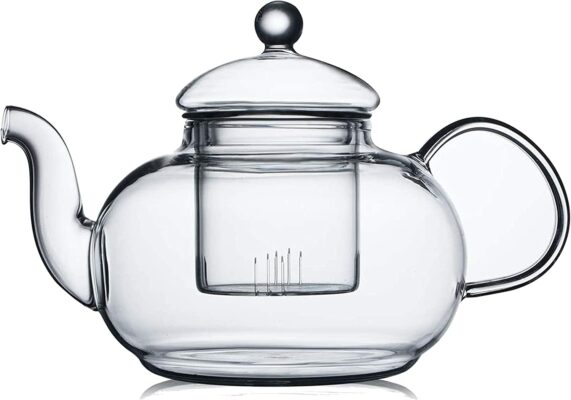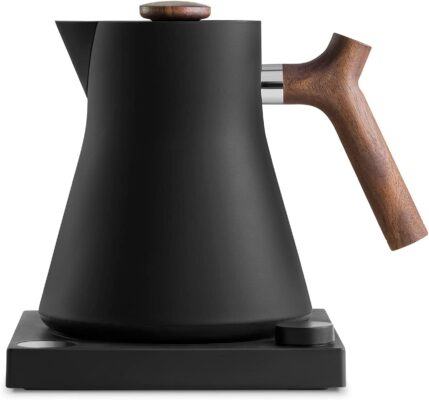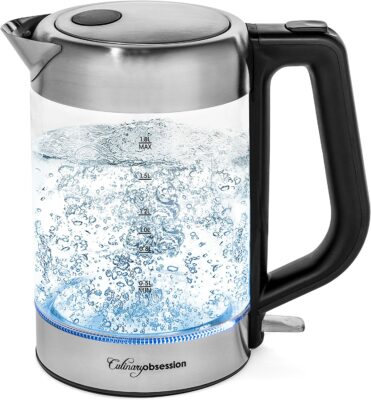A tea kettle is a common kitchen appliance that is used to heat water for making tea. While there are many different types and designs of tea kettles, they all serve the same basic purpose: to provide a convenient and efficient way to boil water.
However, not all tea kettles are created equal, and some are made with materials that can be harmful to human health, such as plastics or metals that may leach chemicals into the water.
This is why it is important to choose a non-toxic tea kettle designed to be safe and healthy for your home.
The importance of a non-toxic tea kettle cannot be overstated. Choosing a kettle made from toxic materials can potentially lead to a range of health problems, especially if the water is heated and consumed regularly.
For example, plastic tea kettles can contain harmful materials such as BPA, which has been linked to various health issues, including cancer, hormonal disruption, and developmental problems.
Similarly, some metal kettles can contain lead or other heavy metals that can leach into the water and cause serious health issues over time.
You can ensure that your tea is free from harmful chemicals and contaminants by choosing a non-toxic tea kettle made from safe materials such as glass, stainless steel, or ceramic.
This is particularly important if you have young children or are pregnant, as exposure to toxins can be especially dangerous for these vulnerable populations.
In this article, we will provide a comprehensive guide to non-toxic tea kettles, covering everything you need to know to choose the best one for your needs.
What Makes a Tea Kettle Non-Toxic?
To understand what makes a tea kettle non-toxic, it’s important to look at the materials used in its construction and the potential health risks associated with each one.
For example, plastic tea kettles can contain BPA, which has been linked to various health problems. Similarly, some metal kettles can contain lead or other heavy metals that can leach into the water and cause health issues over time.
Non-toxic tea kettles are typically made from safe and healthy materials such as glass, stainless steel, or ceramic. Glass kettles are a popular choice as they are free from BPA and other harmful chemicals and do not alter the taste or aroma of the tea.
Stainless steel kettles are also a good option as they are durable, easy to clean, and resistant to rust and corrosion.
Ceramic kettles are another non-toxic option, as they are free from harmful chemicals and provide excellent heat retention. They also come in various designs and colors, making them a stylish addition to any kitchen.
Overall, the key to choosing a non-toxic tea kettle is to look for one made from safe and healthy materials and to avoid those that contain harmful chemicals or metals.
Should I Get a Stovetop Tea Kettle or Electric Tea Kettle?
If you’re a tea lover, you know how important having a good tea kettle is. The question is, should you get a stovetop tea kettle or an electric tea kettle?
Both types of kettles have their pros and cons, so let’s take a closer look at each.
Electric Tea Kettles:
- Convenience: Electric tea kettles are incredibly convenient. They heat up water quickly and can be used anywhere there is an electrical outlet.
- Temperature control: Many electric tea kettles come with temperature control settings, allowing you to heat water to the perfect temperature for your tea.
- Automatic shut-off: Electric tea kettles have an automatic shut-off feature, which will turn off once the water has boiled, preventing the kettle from overheating.
- Energy efficient: Electric tea kettles are more energy efficient than stovetop kettles, as they only use the electricity needed to heat the water.
Stovetop Tea Kettles:
- Classic design: Stovetop tea kettles are classic and can be an attractive addition to your kitchen.
- Whistle: Stovetop tea kettles come with a whistle, alerting you when the water has boiled.
- Durable: Stovetop tea kettles are made of sturdy materials like stainless steel or cast iron and are designed to last a long time.
- Versatility: Stovetop tea kettles can be used on any stovetop, including gas, electric, and induction.
What Materials Are Toxic in Tea Kettles?
Tea kettles are a staple in many households, but not all tea kettles are created equal. Some materials used in tea kettles can be toxic and harmful to your health.
Here are some materials to be aware of when shopping for a tea kettle.
Copper:
Copper tea kettles are a popular choice due to their quick heating capabilities. However, copper is a toxic material that can leach into your water if not lined properly. Overexposure to copper can cause stomach cramps, nausea, and even liver damage.
Aluminum:
Aluminum tea kettles are another quick-heating option, but they can be toxic, like copper. The aluminum can react with certain ingredients in your water, like tea leaves, and leave behind a metallic taste. Long-term exposure to aluminum can lead to neurological damage.
Plastic:
Plastic tea kettles are lightweight and affordable but not the safest option. Plastic can release harmful chemicals, like BPA, into your water when heated, and BPA exposure has been linked to reproductive issues, heart disease, and diabetes.
Porcelain Enamel & Ceramics:
Porcelain enamel and ceramics are common materials for tea kettles, but not all are created equal. Some cheaper options may contain lead, which can be toxic if ingested. Always look for tea kettles that are lead-free.
Exposed Heating Elements:
Some electric tea kettles have exposed heating elements, which can come in contact with your water. If the element is not made of safe material, like stainless steel, it can release harmful chemicals into your water.
Avoid tea kettles made from toxic materials like copper, aluminum, plastic, or leaded porcelain enamel. Your health and safety should always be top priorities, so choose your tea kettle wisely.
Benefits of Using a Non-Toxic Tea Kettle
Using a non-toxic tea kettle can have significant benefits for your health and well-being.
Here are some benefits of using a non-toxic tea kettle.
1. Improves Your Health:
Using a non-toxic tea kettle can reduce exposure to harmful chemicals like lead, BPA, copper, and aluminum. Exposure to these toxic materials can lead to various health issues, including organ damage, neurological disorders, and reproductive issues.
By using a non-toxic tea kettle, you can ensure that you are not ingesting these harmful substances, improving your overall health.
2. Safe for the Environment:
Non-toxic tea kettles are typically made from environmentally safe materials, such as stainless steel or glass. By choosing a non-toxic tea kettle, you reduce your carbon footprint and minimize your environmental impact.
3. Improved Taste:
Tea kettles made from non-toxic materials can enhance the taste of your tea. When you use a tea kettle that is free from toxins and chemicals, you can be confident that your water will not be contaminated, resulting in a cleaner and better-tasting cup of tea.
4. Durable and Long-lasting:
Non-toxic tea kettles made from high-quality materials like stainless steel or titanium are built to last. Unlike cheap plastic or porcelain enamel kettles, non-toxic tea kettles are less likely to break or wear down over time, saving you money in the long run.
Be sure to do your research and choose a tea kettle made from safe, non-toxic materials to reap the many benefits of this essential kitchen tool.
Factors to Consider While Buying Non-Toxic Tea Kettle
When shopping for a non-toxic tea kettle, there are several important factors to consider.
Here are some of the key things to keep in mind when looking for a non-toxic tea kettle.
Material:
The material used in your tea kettle is one of the most critical factors. Look for a tea kettle made from non-toxic materials like stainless steel, glass, or titanium. Avoid tea kettles made from materials that can be harmful, such as copper, aluminum, or plastic.
Capacity:
Consider the size of your tea kettle and how much water it can hold. Choose a larger-capacity tea kettle if you regularly make tea for multiple people. On the other hand, if you only make tea for yourself, a smaller capacity tea kettle may be sufficient.
Heating Source:
Another factor to consider is how you will heat the tea kettle. You can choose between a stovetop tea kettle or an electric tea kettle. If you prefer a stovetop tea kettle, be sure to choose a model that is compatible with your stovetop.
If you prefer an electric tea kettle, look for one that has an adjustable temperature setting and an automatic shut-off feature.
Design and Style:
Tea kettles come in a wide range of designs and styles, so you can choose one that matches your kitchen decor. You can find tea kettles in various colors, patterns, and shapes, so consider your personal style when selecting a non-toxic tea kettle.
Price:
The price of a non-toxic tea kettle can vary widely depending on the material, capacity, and design. While choosing a tea kettle that fits your budget is essential, don’t compromise on quality.
Investing in a high-quality non-toxic tea kettle can save you money in the long run by lasting longer and being more durable.
Remember to prioritize your health and choose a tea kettle made from non-toxic materials to ensure a safe and healthy cup of tea.
Top 5 Non-Toxic Tea Kettles

CnGlass 33.8oz Glass Teapot

OXO BREW Classic Tea Kettle

All-Clad Stainless Steel Tea Kettle

Fellow Corvo EKG Electric Tea Kettle

Culinary Obsession Tea Kettle
How to Care for Your Non-Toxic Tea Kettle?
Caring for your non-toxic tea kettle ensures its longevity and maintains its non-toxic properties.
Here are some tips on properly cleaning and maintaining your non-toxic tea kettle.
Cleaning Your Non-Toxic Tea Kettle:
To keep your non-toxic tea kettle in top condition, you need to clean it regularly.
Here’s how:
- Fill the kettle with equal parts of vinegar and water.
- Bring the mixture to a boil and let it sit for 10-15 minutes.
- Dump the solution and rinse the kettle with clean water.
- Wipe the kettle dry with a clean towel.
This method will remove any mineral deposits or residue from the inside of the kettle. You can also clean the exterior of your tea kettle with warm soapy water and a soft cloth.
Maintaining Your Non-Toxic Tea Kettle:
Here are some tips for maintaining your non-toxic tea kettle:
- Use a soft sponge or cloth to avoid scratching the surface of the kettle.
- Avoid using abrasive cleaning materials or harsh chemicals that can damage the non-toxic properties of the kettle.
- Keep your tea kettle away from direct heat sources or open flames.
- When not in use, store your tea kettle in a cool, dry place to prevent corrosion or damage.
By following these simple tips, you can extend the life of your non-toxic tea kettle and ensure that it continues to provide you with healthy and safe tea for years to come.
Regular cleaning and proper maintenance are essential to keep your tea kettle in top condition. Be sure to follow the tips above to keep your non-toxic tea kettle safe, clean, and functioning properly.
Are All Tea Kettles Safe?
While tea kettles are a common kitchen appliance, not all tea kettles are safe. Some tea kettles may contain harmful materials that can leach into your drinking water and affect your health. Choosing a safe tea kettle is essential to ensure a healthy and enjoyable tea-drinking experience.
The safety of a tea kettle depends on the materials it is made from. Some materials, like plastic or aluminum, can be harmful when exposed to high temperatures or when they come into contact with acidic liquids like tea.
On the other hand, tea kettles made from non-toxic materials like stainless steel, glass, or titanium are safe and healthy to use. These materials do not contain harmful chemicals that can leach into your drinking water, ensuring your tea is safe and enjoyable.
Another factor to consider regarding tea kettle safety is the heating source.
Electric tea kettles are generally considered safer than stovetop ones as they have built-in safety features like automatic shut-off and temperature control. Stovetop tea kettles require more attention and can be dangerous if left unattended or overheated.
What is the safest tea kettle material?
Choosing a safe and non-toxic tea kettle material is important for maintaining the purity and health of your tea. Two of the most popular and safest options available are borosilicate glass and high-quality/food-grade stainless steel.
Here are some of the benefits of each:
Borosilicate Glass Tea Kettle:
- Resistant to thermal shock, meaning it can withstand rapid temperature changes without cracking or breaking
- Free from harmful chemicals such as BPA and phthalates
- Does not affect the taste or aroma of the tea
- Easy to clean and does not retain odors or flavors from previous use.
- Lightweight and portable, making it a great option for travel or on-the-go use.
High-Quality/Food-Grade Stainless Steel Tea Kettle:
- Durable and resistant to rust and corrosion
- Does not contain any harmful chemicals
- Does not affect the taste or quality of the tea
- Often made with double-walled construction, which helps maintain the water temperature for longer periods.
- Easy to clean and maintain, and often comes with a sleek and modern design.
Ultimately, these two options come down to personal preference and lifestyle. If you prioritize portability and ease of use, a borosilicate glass tea kettle may be your best option.
A high-quality stainless steel tea kettle may be the better choice if you prefer a more durable and long-lasting option with advanced features.
Regardless of which option you choose, it is important to make sure that the materials used in the kettle are of high quality and free from harmful chemicals.
Investing in a safe and non-toxic tea kettle lets you enjoy your tea with peace of mind and without any concerns about potential health risks.
How to Use a Stovetop Glass Tea Kettle?
Stovetop glass tea kettles are popular for those who prefer a traditional and classic tea-making approach.
Here are some steps to follow for using a stovetop glass tea kettle:
- Fill the kettle with water: First, fill the kettle with the desired amount of water. Ensure not to fill the kettle to the top; the water will expand as it heats up.
- Place the kettle on the stove: Next, place the kettle on the stove and turn the heat to high. It’s important to place the kettle on the correct-sized burner to ensure even heating.
- Monitor the water temperature: As the water heats up, monitor the temperature with a thermometer or by keeping an eye on the water as it boils. The ideal temperature for different types of tea can vary, so make sure to check the recommended temperature for the specific type of tea you are brewing.
- Remove from heat and add tea: Once the water has reached the desired temperature, remove the kettle from the heat and add the tea leaves or tea bags to the water. The amount of tea you use will depend on your preference and the tea you are brewing.
- Steep the tea: Cover the kettle with a lid and allow the tea to steep for the recommended amount of time. This will vary depending on the type of tea but generally ranges from 2-5 minutes.
- Pour and enjoy: After the tea has steeped, carefully pour the tea into your mug or teapot. You can use a strainer to remove any loose tea leaves. Add honey, sugar, or milk as desired, and enjoy your freshly brewed cup of tea.
Stovetop glass tea kettles are a great option for those who appreciate the traditional tea-making approach. By following these simple steps, you can brew a delicious and satisfying cup of tea right from the comfort of your own home.
Conclusion
In conclusion, selecting a non-toxic tea kettle is important for maintaining your health and well-being. The materials used in tea kettles can have potential health risks, so choosing a safe and non-toxic option is essential.
We discussed the importance of using non-toxic tea kettles and the potential health risks of toxic materials. We also explored the safest materials for tea kettles, including borosilicate glass and high-quality stainless steel.
Furthermore, we discussed the pros and cons of stovetop and electric tea kettles, helping you decide which option is best for your needs.
Enjoy your tea safely and healthily!
